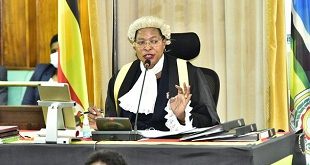
Hoima, Uganda | THE INDEPENDENT | The government has launched the National Oil Spill Contingency Plan, a disaster preparedness and management framework, in case of an oil spillage incident in the industry.
The plan is aimed at preventing or managing disasters that may arise when a liquid or semi-liquid petroleum hydrocarbon, either crude or final product, is released into the environment mainly due to human activity.
This is part of the safety preparations for the commercial production of oil which is expected to start in 2025, but will also be applied during exploration and appraisal stages.
Oil spills may be caused by releases of crude oil from tankers, offshore platforms, drilling rigs, wells, and refined petroleum products or the spill of any oily refuse or waste oil.
Oil spills can have far-reaching disastrous consequences for the environment, communities, human and wildlife health as well as the economy.
The impact depends on factors like the size and duration of the spill, the location, whether it happens on water or on land.
Apart from the bursting tankers and pipelines that eventually cause fire, most prominent spills have been recorded as happening in water bodies in different parts of the globe.
The Albertine Graben, where the oil activities are concentrated, is one of the most ecologically-diverse regions in the world, with thousands of animal, bird and plant species, including 52 percent of all African birds, and 39 percent of African animals.
Ernest Rubondo, the Petroleum Authority of Uganda Executive Director, says the Plan caters for all the stages of the petroleum value chain, from the exploration and production region, through to the transportation and refinery.
For adequate management of any incident, the plan provides for tiered preparedness and response, in line with the scope of the likely effect.
The three-tiered structure allows those involved in contingency planning to describe how an effective response to any oil spill will be provided, from small operational spillages to a worst-case release on land or water.
Tier 1 is the lowest response level and may be restricted to a site. The licensees, operators and other persons responsible are expected to be able to fully respond to this level of spill incident.
The second level, Tier 2, refers to small-to-medium impact incidents. Under this, the operators should have the capacity to respond immediately or mobilise support from other licensees to handle this spill.
In some circumstances, support from government, regional and international services may be required.
The worst-case scenario is the large-scale spill where licensees or operators in petroleum activities, midstream operations and petroleum supply are required to have membership with suppliers of Tier 3 spill services and equipment suppliers.
In case of an incident, the government may also decree that resources belonging to any person in the country may be taken over for use to address this incident. The framework also gives guidance on identifying the hazard and assessing the vulnerability and risk.
Dr Barirega Akankwasa, the Chief Executive, National Environment Management Authority, NEMA, says this helps makes informed decisions in responding to an incident.
An oil spill may potentially escalate from small spill to medium spill through to large spill, requiring Tier 1, Tier 2 or Tier 3 response, respectively, so the structure provides a mechanism to identify how individual elements of capability will be arranged and applied.
The international oil companies have also developed their own contingency plans as part of internal policies on safety, but also as international best practices.
Energy and Mineral Development Minister Ruth Nankabirwa says this national plan is not aimed at replacing the individual plans of the companies, because the companies will be largely be responsible in case of a spill.
This, according to PAU Boss Rubondo, calls for the international oil and gas investors to be extra careful because they will have to pay for any cost of the spill.
Prime Minister Robinah Nabbanja called for the sensitization of all Ugandans, but mainly those communities within the Albertine Graben and alongthe pipeline, about the Oil Spill Contingency Plan.
This, according to her, is vital to ensure that the public knows how to sight or suspect an oil spill and how to respond, for quick and effective management.
After a spill has occurred, cleanup and recovery are difficult and depend upon many factors, including the type of oil spilled, the temperature of the water (on how it can affect evaporation and biodegradation), and the types of shorelines and beaches involved.
In case of a spill in water, the oil can suffocate the living things under the water by blocking oxygen reaching them.
Water birds swimming or wading on the water will be affected because when the oil infiltrates their feathers, it makes movement difficult, as well as impacting on their bodies ability to generate warmth.
The Deepwater Horizon oil spill in Mexico in 2010 has been recorded as the largest oil spill in recent history, discharging almost 5,000 barrels of oil per day in the Gulf of Mexico.
The International Maritime Organization this week undertook the “first responder training” which featured participants drawn from various government MDAs in Nwoya, Buliisa, Kikuube and Hoima districts.
Officials from the PAU, NEMA and OPM are scheduled to undertake an Oil Spill Clearance training in April 2022, as part of the implementation of the Plan.
The plan includes Equipping oil spill incident command centers, facilitating establishment oil spill response equipment hubs, supporting development of the Contingency Plans for Government Lead Agencies and District Local governments, among others. It also involves developing a framework for collaborations.
****
URN
 The Independent Uganda: You get the Truth we Pay the Price
The Independent Uganda: You get the Truth we Pay the Price


